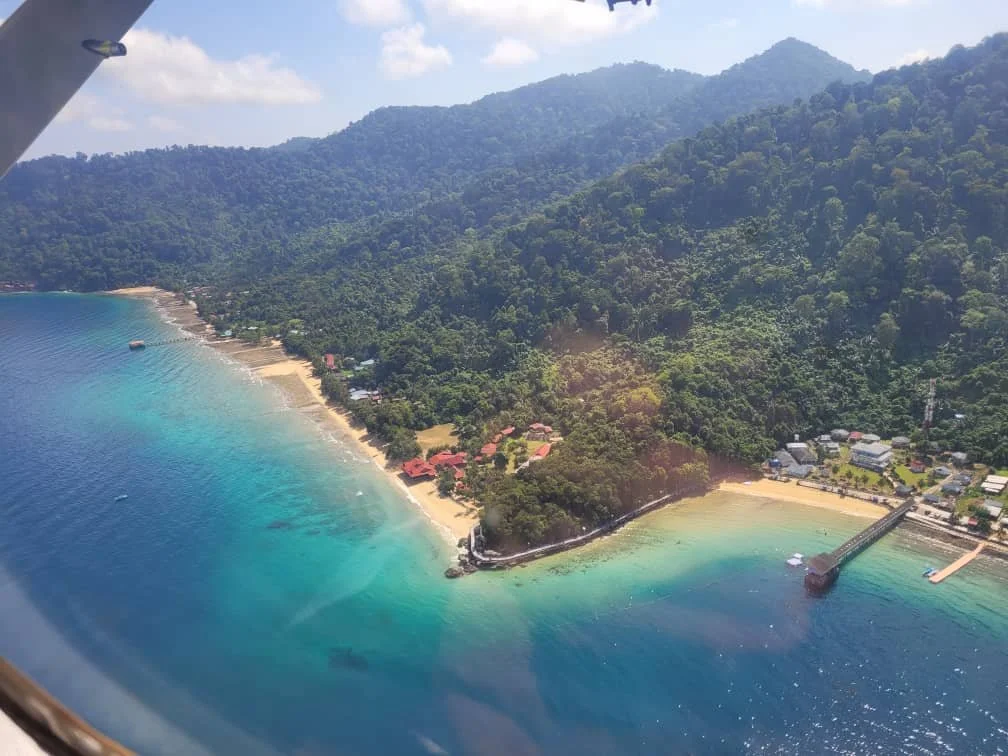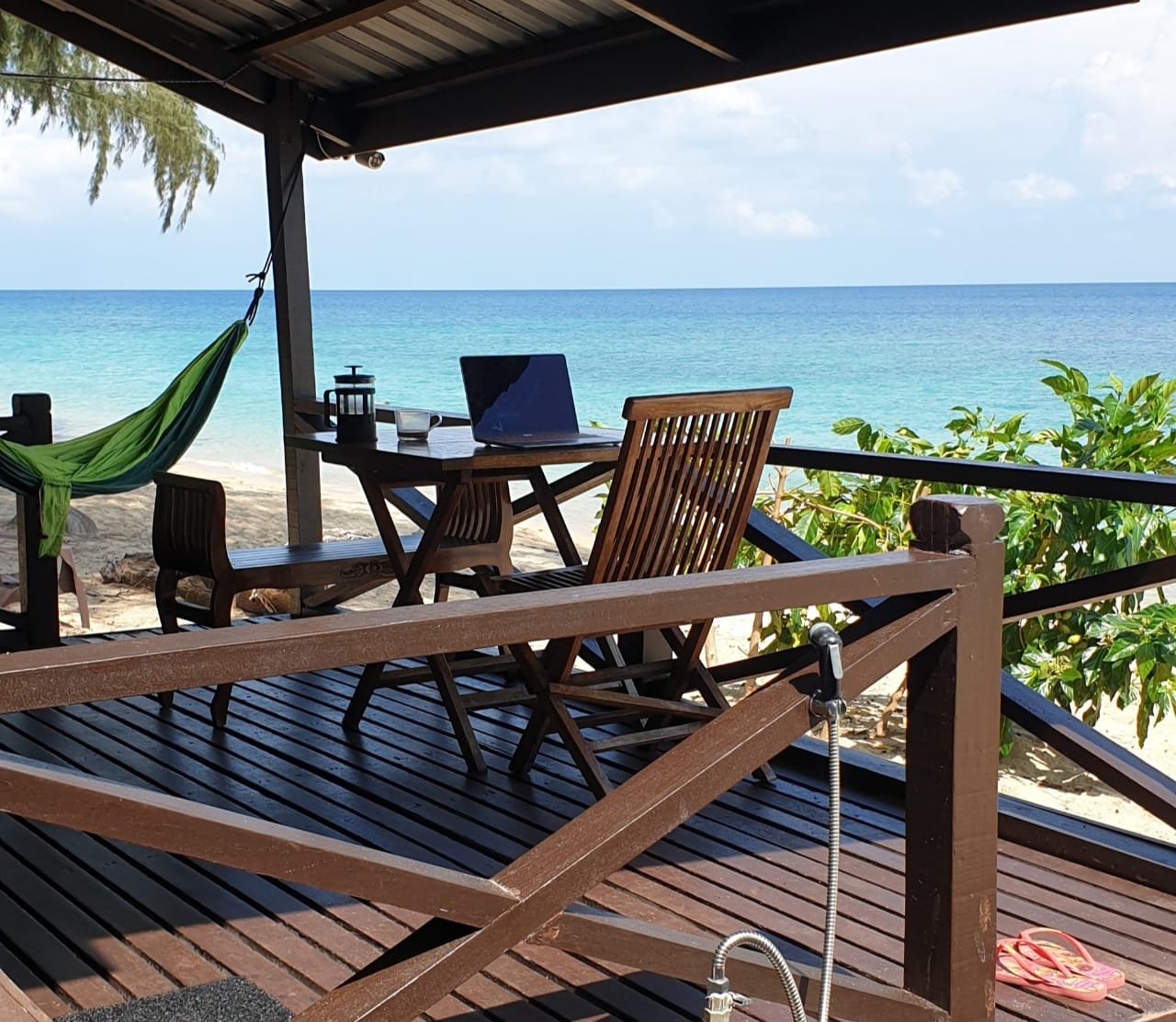Tioman Island, located off the coast of Peninsular Malaysia, is known for its stunning white sandy beaches with palm trees swaying in soft breeze and pristine coral reefs. But this island has much more to offer.
Francien and I settled into our narrow seats at the front of the Twin Otter plane. This plane can only take 19 passengers, it’s a STOL (Short Take-Off and Landing) plane, has no pressurized cabin and therefore flies no higher than 10000 feet. The plane is so small that we had to hunch over on our way in. Once inside the ground staff pulled up and closed the rear door, the pilots pulled down the controls and after a short charge along the runway we lifted off the ground from Subang airport in a steep climb. The sound of the two turbine engines was deafening. We ascended over Kuala Lumpur and then the plane soon levelled out, travelling low enough to ensure a clear aerial view of the Malaysia peninsula with its oil palm plantations lined with rainforests, muddy rivers winding snakelike to the sea, forest clearings and kampungs. We flew across the Titiwangsa mountain range that forms the backbone of the Malay Peninsula, with its 5000 feet high peaks.
Our pilots preparing for departure
Since my seat was virtually in the cockpit, I could see the radar and the clock ticking down to our landing time and location. Within 70 minutes of take-off, we descended to our destination. The Tioman airstrip is tucked against a mountain on one side and the South China Sea on the other. The plane took a sharp turn and then I saw the tarmac floor a few meters away from me: …thud.…. a one wheel first landing which shook the plane. .
Arriving at the Tioman airstrip
The runway, built by the Japanese in WWII, is only 990 meters long, but this plane needs only 400 meters to come to a safe complete stop!
According to local legends, the island was formed when Sri Gunom, a dragon princess, was cursed when she disobeyed the gods. In the tale, she visited her sister, Gunung Linga, against the wishes of the majestic beings. When she fell from the sky, she became Tioman Island.
Together with our local guide Sam, we hiked up the Dragon Horn twin peaks (named after this legend). It was a tough 2-hour climb. Apart from the always challenging heat and humidity, we had to crawl on our knees underneath a thick bamboo forest, through dense jungle foliage and thorny tendrils. We walked on mossy boulders and slippery slopes, often tripping on the massive roots and climbing across fallen tree trunks. Bring not only good hiking shoes, but also gloves, because at the top you need to do some climbing with ropes and rope ladders. We reached the ridge connecting both peaks at 510 meters and enjoyed the view across kampung Mukut, the dark blue sea and the lush greenery of the tropical rainforest covering the island.
Mukut jetty with the Dragon Horn’s in the background
With our guide Sam at the start of the climb up the Dragon Horn’s
The climb became steeper towards the top
Taking a rest and sipping coffee freshly made by Sam
We reached the end of the trail after a 510 meter climb and enjoyed the view
Holding the rope heading downhill
A quick photo snap inside the dense bamboo forest
What better way to recover after such a trek with a dip in refreshing and crystal-clear water? We walked to the Asah waterfall located at the semi-abandoned village of kampung Asah, just a few minutes by boat from Mukut. A beautiful cascade that drops into a pool amid huge granite slabs. We chilled in this pool before heading back to the boat, which took us back to our favourite beach front chalet ‘The Station Tioman’ in Tekek, the main kampung on the island.
Refeshing dip in the Asah waterfall
The Station Tioman in Tekek
Another adventure was a hike from the west side of the island across a 400-meter-high mountain ridge to kampung Juara on the opposite side. Our guide Paklan showed us the rare Rafflesia flower, the largest single flower in the world. It was in full bloom. A Rafflesia in full bloom is a rare sight as it only blooms 3-5 days a year at completely random times. Paklan also pointed out chameleons which indeed are masters in disguise. The island is home to 26 different species of these not-shy creatures. We saw a few snakes, monitor lizards, many groups of long-tailed macaque monkeys, geckos, butterflies and tiny flying lizards. We could hear the chirping and hooting noises of the insects and birds. Just outside kampung Juara, we paddled on kayaks in the mangroves, around air roots and massive nipa trees. We spotted a few pythons curled up high above us in the trees. In the evening we saw flying foxes leaving their hang-outs to start feeding in the darkness.
Rafflesia flower in full bloom
Massive roots on the trail
Paklan shows Francien a chameleon
Spot the chameleon……..
Kayaking in the mangrove forest
There are still many secluded beaches on this island which can only be reached via the sea. One day we loaded our camping gear onto a boat. The boatman, Ris and his wife Sarah, dropped us off onto one of these remote beaches. We put up our tents and built a campfire from driftwood to prepared our food on it. The smoke helped to keep the mosquitos away a great deal as we enjoyed some overnight camping. There was only the five of us, between the rainforest and coral fringed 200-meter-wide bay. One of us always stayed close to our tents to chase the monkeys away who wanted to snatch some of our food. At night we could hear the hermit crabs crawling underneath our tents. Unfortunately, the earth’s oceans are polluted with plastic trash and also on this remote beach we found many used plastic bottles, fishing nets, food wrappers and even shoes and slippers. We collected these and burned them to leave a cleaned beach behind. The next day at high tide Ris and his family came back to pick us up and we returned to Tekek.
Loading our camping gear onto the boat
Our campsite ready for the night
Our campfire
The oceans are polluted with plastic. The least we could do is to clean up the beach on which we camped
Although Pulau Tioman is one of Malaysia’s East coast most commercially developed islands, many parts of the island are completely untouched by tourists, because all the resorts and kampungs are close to the beaches. We had a great time in the beautiful nature on this island, away from the tourist hotspots.
The last day we boarded the SKS Airways plane again and within hours we were back in buzzing Kuala Lumpur: the contrast could not have been bigger….
The preferred mode of transport in the kampung


